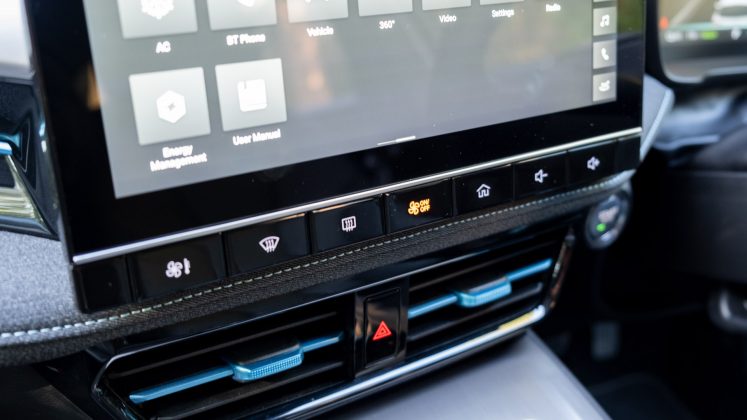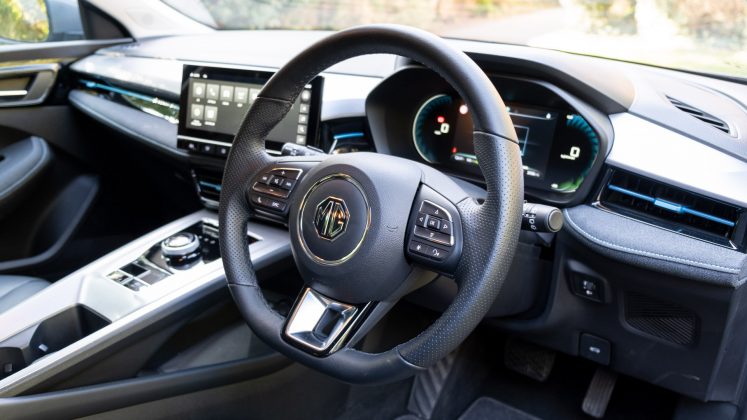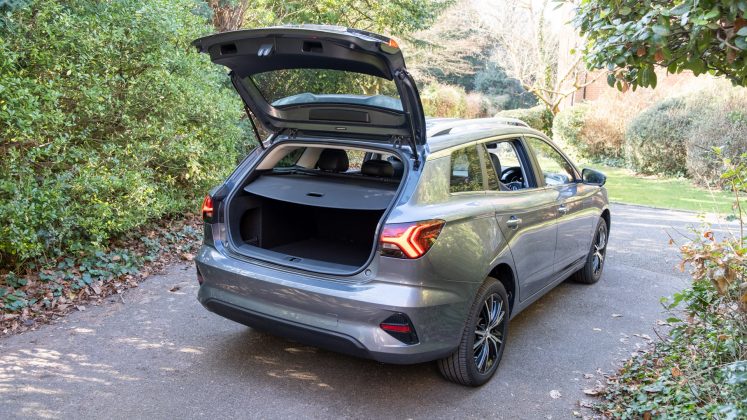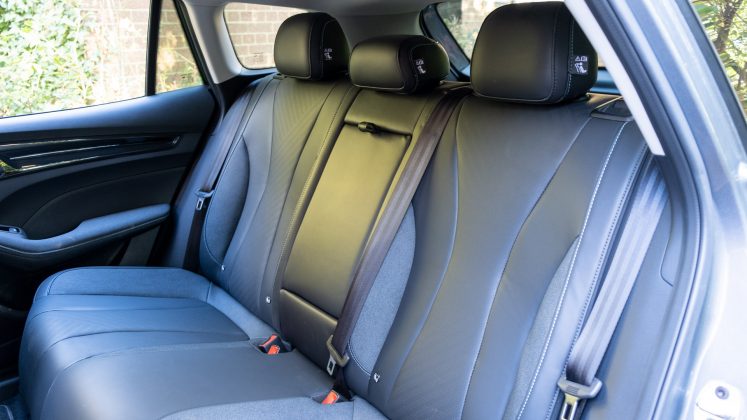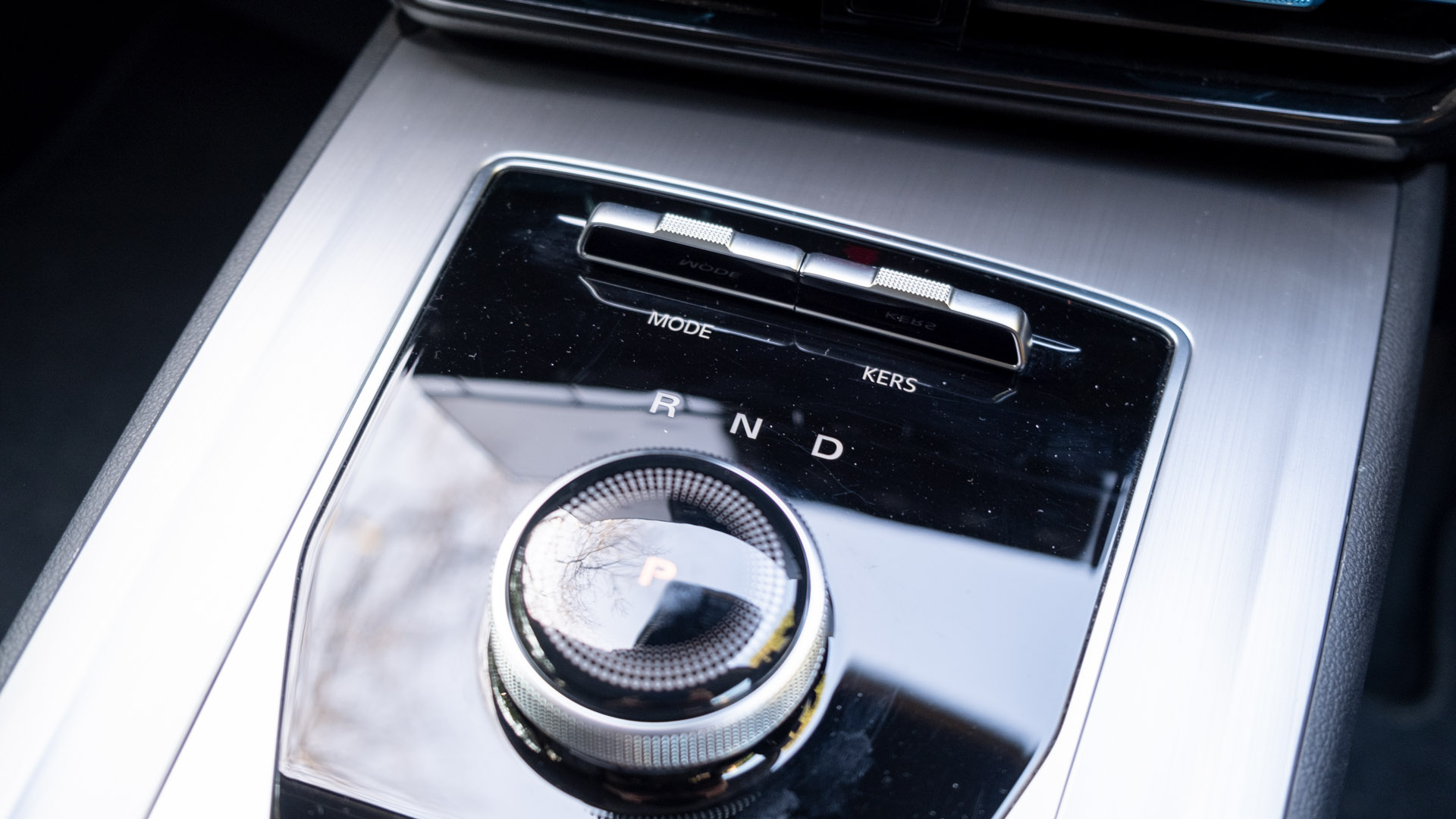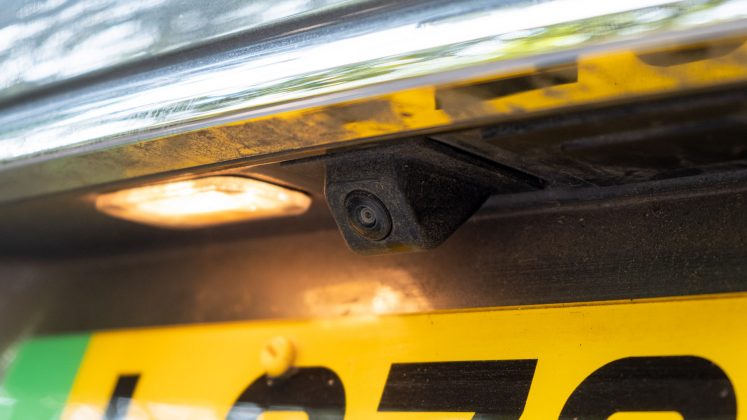When we reviewed the MG5 EV in 2021 it was the only fully electric estate on the market. Fast-forward a few years and it still remains unchallenged. Unless, of course, you have £76,500 or more to splash out on the lavish Porsche Taycan Cross Turismo. Indeed, at the time of writing, there’s nothing that quite competes with the MG5 EV, which has since received a complete overhaul, making it far more attractive to prospective EV buyers.
If you’d prefer to watch a review of the MG5 EV, head on over to our YouTube channel.
MG5 EV price & competition
Given the lack of options, you might expect MG Motor to have significantly ramped up its asking price. Thankfully, that’s not the case, with the price of the MG5 EV Long Range starting from £30,995 for the SE Long Range and rising up to £33,495 for the Trophy Long Range. A breakdown of the differences can be found below (click to expand):
Granted the new MG5 EV costs more than its predecessor (£25,095-£27,595), however, this is due to the UK government scrapping the plug-in car grant (PiCG) and the now-Chinese-owned manufacturer offering a much larger battery pack, which undoubtedly affects manufacturing costs.
As we’ve already established, there’s no direct competition at this price point, rather you’ll find a flurry of all-electric SUVs: the MG ZS EV from £30,495; the Citroen e-C4 from £31,995; the Hyundai Kona Electric from £32,450; the Kia Soul EV from £32,845; the Peugeot e-2008 from £35,900; the Vauxhall Mokka-e from £36,335; the Kia Niro EV from £36,795; the Volkswagen ID.4 from £38,845; the Skoda Enyaq iV from £38,970; and the Tesla Model Y from £44,990.
You might also want to consider a few of the more practical hatchbacks and saloons: the MG4 EV from £26,955; the Nissan Leaf from £28,995; the GWM Ora Funky Cat from £31,995; the Cupra Born from £36,475; the VW ID.3 from £39,425; and the Tesla Model 3 from £42,990.
Read next: Kia Niro EV review: An upgraded e-Niro?
MG5 EV exterior review
One of our biggest complaints about its predecessor was the exterior design. It simply lacked imagination. However, the updated model is far more attractive and snazzy. It oozes class with its aggressive profile at the front, has 16″ alloys with aero covers or 17″ alloys with body-coloured wheel arches and side skirts, and a rear design to match. It’s far more attractive, which we suspect will lure certain consumers towards it.
In terms of your colour options, ‘Arctic White’ comes as standard. However, should you want, ‘Piccadilly Blue’, ‘Black Pearl’, ‘Cosmic Silver’ or the pictured ‘Hampstead Grey’ you’ll have to spend an extra £545, while ‘Dynamic Red’ comes in at £695.
Aside from paint finishes, the more expensive Trophy Long Range features a rear privacy glass. Meanwhile, both trims have an integrated roof rail, whereby the vehicle can take up to 75kg of additional weight (up from 35kg of its predecessor). As for your towing capacity, it’s rated at 500kg, which is rather disappointing as most electric SUVs can pull north of 750kg.
Read next: Citroen e-C4 review: Most comfortable SUV?
MG5 EV interior review
It’s not only the exterior of the vehicle that’s been refreshed but also the interior. It looks a bit more upmarket and includes bigger digital displays. Indeed, the instrument cluster is no longer part-analogue, as it now sports a vivid and customisable 7″ screen that provides all the key driving information that one might need. At the centre of the dashboard, there’s an intuitively laid out 10.25″ infotainment system that provides access to Android Auto and Apple CarPlay over a wired connection.
While the updated displays are certainly appreciated, we did experience a multitude of problems with connectivity, namely surrounding Android Auto. The mobile operating system would refuse to re-establish a connection after being used. Equally, when the phone was unplugged, the infotainment system would fail to play media over a Bluetooth connection, oddly thinking Android Auto was still running. Our only solution was to fully reset the vehicle. We had to do this a multitude of times during our tests, which left us frustrated. Given we experienced similar issues with MG4 EV, which was tested using a different phone and cable, it would seem MG’s systems are problematic. We’ve reached out to the manufacturer for comment and will update this review if and when there’s a proposed solution.
Nonetheless, if you don’t encounter any issues, you’ll be able to utilise the vehicle’s six-speaker configuration. It fares well across the frequency range but won’t excite audiophiles. You can hear how the system performs by watching our dedicated audio review on YouTube.
The use of technology within the cabin certainly takes centre stage, but it’s great to see that the manufacturer hasn’t omitted physical buttons and has retained a practical design throughout. There are quick-access buttons found below the 10.25″ display, and useful controls by the centre console and the steering wheel.
Read next: Tesla Model Y review: Best electric SUV?
MG5 EV storage review
Onto storage, you’ll find plenty of areas within the cabin. At the front, there’s the glove box, the large door bins and under the centre console a large open storage compartment with a non-slip cover. Here, you’ll also find two USB Type-A ports and a 12V socket that can be handy to provide power to a dash cam. There’s a Type-A and Type-C port found at the rear too. As for the top part of the centre console, there are two cupholders and a small area found within the armrest.
At the rear of the cabin, there are two cupholders found within the pulldown armrest and of course, you’ll find the door bins, which very much like the ones found at the front, aren’t lined with fabric meaning loose change and keys will be heard rattling around when traversing uneven terrain.
The key selling point, however, is the MG5 EV’s boot capacity. With the seats in place, there’s 479 litres and with them folded down there’s 1,367 litres. While that’s marginally down from its predecessor at 464 and 1,456 litres respectively, it’s still plenty sufficient.
Here is how it stacks up to a few of its rivals: Tesla Model Y (854/2,100 litres); Skoda Enyaq iV (585/1,710 litres); VW ID.4 (543/1,575 litres); Kia Niro EV (475/1,392 litres); Peugeot e-2008 (434/1,467 litres); MG ZS EV (448/1,375 litres); Kia Soul EV (315/1,339 litres); Citroen e-C4 (380/1,250 litres); MG4 EV (363/1,177 litres); Hyundai Kona Electric (332/1,114 litres); Vauxhall Mokka-e (310/1,060 litres).
When it comes to practicality, the tailgate has that hatchback design making it convenient to load in and out goods. However, it’s manually operated only with no option to add electric controls via an option. Speaking of convenience, the boot floor is somewhat flat but due to the design of the rear seats means it’s not quite as practical as some of its rivals. There’s also no through-loading capabilities with MG opting for 60:40 rear split-folding seats.
Elsewhere, there’s no front storage compartment (frunk), which will come as a disappointment to certain EV enthusiasts, especially given that there’s enough space underneath the large plastic cover. On the other hand, there’s a sizeable underfloor area which can be used to transport the vehicle’s charging cables.
Read next: Skoda Enyaq iV review: The Volkswagen ID.4 alternative
MG5 EV comfort review
Moving onto comfort, the MG5 EV can seat up to five 6-foot (182cm) adults. Headroom and legroom at the front and rear of the cabin are sufficient, but the estate won’t compete with some of the larger-sized fully electric SUVs. Unlike some of its rivals, however, the rear footwell design is completely flat; this makes for a more comfortable seating experience for those sitting at the back.
The seats themselves are very accommodating with the front two featuring manual controls. The driver’s seat becomes electrically operated and both front passengers will gain heating controls in the Trophy trim. However, neither the SE nor the aforementioned model features a heated steering wheel or windscreen.
As for cabin noise, the MG5 EV provides decent sound insulation but does suffer from road and wind noise at higher speeds. There’s also some low-end resonance that can be heard when traversing rougher terrain – you’ll find our sound measurements and more details in our dedicated audio review.
Aside from this, it’s disappointing that MG doesn’t provide a sunroof or a panoramic glass roof to its customers. We’d have liked this to be an option for those who want to draw in some extra light within the cabin.
Read next: Kia EV6 review: The Hyundai Ioniq 5 alternative
MG5 EV performance review
Now what also contributes to overall driving comfort is the vehicle’s suspension setup. Here, the MG5 EV has a soft configuration, which is certainly appreciated as it soaks up anomalies, speed bumps and potholes extremely well when pottering around town. Of course, this does mean that the vehicle suffers from body roll and isn’t best served for spirited driving – with that said, we can’t expect the target crowd will be too bothered.
Equally, the lack of a one-to-one driver’s feel and connection hinders the MG’s capacity to be driven at speed on windy country roads. This becomes inherently apparent given its front-wheel drive (FWD) configuration fails to provide the utmost traction. When putting your foot down when exiting a corner or driving on wet tarmac, you’ll find the MG5 EV suffers from front wheel spin. It’s not severe nor does it suffer from torque steer when driving carefully but rather, should be taken into consideration if you have a heavy foot.
This leads us to performance. The front-mounted motor when combined with its battery pack dispatches 115 kW (154hp) of power and 280 Nm of torque. We had it tested from 0-60mph using Racelogic’s Vbox Sport at 8.02 seconds, which is certainly impressive for a vehicle of its class. Top speed is limited to 115mph.
While straight-line speed is important, we suspect many will care more about its electric range. Here, the new MG5 EV houses a 57.4 kWh (61.1 kWh gross) battery pack, which is up from its predecessor’s 48.8 kWh (52.5 kWh gross) capacity. On paper, MG claims the new model will run for 235-250 miles without having to stop. In our mixed driving tests, we found the vehicle netted 210-230 miles instead. By comparison, the older model managed 180-190 miles instead.
Buy a car phone mount on Amazon (Affiliate)
Now to put this into context, here’s how its SUV rivals faired in the very same tests: Peugeot e-2008 140-160 miles; Vauxhall Mokka-e 150-170 miles; Citroen e-C4 180-200 miles; Kia Niro EV (no heat pump) 205-225 miles; MG ZS EV Long Range 230-250 miles; Hyundai Kona Electric 64 kWh, Kia Soul EV (with heat pump), and VW ID.4 (no heat pump) 260 miles; Tesla Model Y Long Range 250-280 miles; and the Skoda Enyaq iV 80, 300 miles.
As for the hatchbacks: the entry-level Tesla Model 3 230-250 miles, the MG4 EV Long Range 220-240 miles, the VW ID.3 230 miles, the Cupra Born 210-220 miles, the Nissan Leaf Tekna e+ 200 miles, and the GWM Ora Funky Cat 140-160 miles.
In order for you to be as efficient as possible and attain the best range, you’ll want to enable a degree of regenerative braking. Here, the KERS (kinetic energy recovery system) switch that can be found on the centre console allows you to flick between Level 1, 2 and 3. The latter is the harshest mode one can select, with it decelerating the vehicle more aggressively when lifting off the accelerator pedal. While there’s some customisation, it’s a shame that isn’t a one-pedal mode, and that the KERS level doesn’t have a memory function, thus each time you step inside the cabin it’ll default to Level 2 – a little cumbersome.
To recharge at a much more rapid rate, there’s a CCS and Type 2 port found at the front of the vehicle. Dissapointely via the former input, the MG5 EV is capped at 87 kW. Meaning a 10-80% charge will take roughly 35 minutes. Should you use a 50 kW charge point, it’ll take 61 minutes instead.
Another letdown is that MG, at least at the time of writing and in the UK, hasn’t included an 11 or 22 kW onboard charger, which means those wanting to quickly top up using three-phase power will be disappointed. Indeed, the Type 2 port is limited to 7 kW, which means 0-100% charge will take 10 hours. This extends to over 21 hours using a three-pin wall plug.
Elsewhere, the MG5 EV promises vehicle-to-load (V2L) capabilities but we were unable to test this feature as our press vehicle didn’t come with an adapter. For those unaware, V2L allows you to discharge a vehicle’s battery pack in order to provide power to another device, such as a kettle or even to charge another EV at a rate of 2.3 kW.
Read next: Porsche Taycan Cross Turismo review: Best electric Porsche?
MG5 EV safety review
In terms of safety, the MG5 EV hasn’t been tested by Euro NCAP, so we can’t comment on crash resistance but can talk about the driver assistance systems. As standard, both models have the following: Active Emergency Braking with Pedestrian and Bicycle Detection, Lane Keep Assist (LKA) with Lane Departure Warning System (LDWS), Traffic Jam Assist, Intelligent Speed Limit Assist, Intelligent High Beam Assist and Adaptive Cruise Control.
They’re all certainly appreciated, though, the latter system does fail to regulate the distance from the leading vehicle, which can lead to a somewhat jerky experience. As for LKA, it re-enables each time you step inside the cabin, but via a press of a button located on the left-hand stalk, one can quickly disable the feature – much appreciated, as a lot of its competitors require you to faff around with the vehicle’s infotainment system instead.
As for visibility, it’s excellent throughout with a rear wiper included as standard; if you have an adult sitting in the rear middle seat it’ll unsurprisingly block your vision. Thankfully, MG has incorporated rear parking sensors and a rearview camera as standard on both trim levels. Should you want a full 360-degree view of the vehicle and rain-sensing wipers, you’ll want to opt for the Trophy model instead. Our only complaint is that the cameras have got an extremely low resolution – for a modern vehicle, it’s really not up to scratch.
Read next: MG4 EV review: The best value EV to date
TotallyEV’s verdict on the new MG5 EV
Overall, the MG5 EV could be improved in certain areas, such as refined features, longer electric range and better-optimised technology within the cabin. Still, given its asking price, driving comfort, storage space, occupant capacity and stylish design, it’s easy to actively recommend the fully electric estate over rival alternatives. As such, the unrivalled electric estate receives TotallyEV’s Best Buy award.
What do you make of the new MG5 EV? Let us know in the comments section below or via social media; we’re on: YouTube, Instagram, Facebook, Twitter and LinkedIn.



























